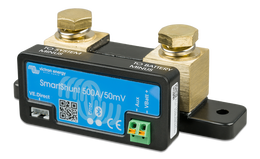Until we didn’t.
At first I was in denial. Then I checked everything four times. How could we possibly run out of power with such a large battery bank? The question was impossible to answer because I really didn’t know how much energy we were using.
A battery monitor would do this so I studied up on what was available on the market. Sadly, the idea of wiring in a shunt and then finding a location for one more gauge seemed like a daunting task, especially considering the hundreds of dollars many of them cost.
Then I found, on one of my favorite Youtube channels DIY Solar Power with Will Prowse, a review of a new device for monitoring batteries. Victron was marketing a Smart Shunt with Bluetooth that would do everything I wanted. It uses a phone or tablet for a display, and is easy to install.
The Victron shunt provides a large amount of information both numerically and graphically, but the most valuable information was the net Ah consumption; how much power did we take out of the battery and how much of that did the charging system put back?
A real-life test happened on our first anchorage of the year. During three February days I carefully watched the system, looking at all the data and happily relating that to the largest and smallest loads. It became obvious on the first day that the batteries were not doing well. The amount of power we were using verses the voltage of the batteries didn’t match up. It took another day for me to wrap my head around what I was seeing. On the third morning we didn’t have enough power to run our hydronic heater.
One note. On return to the dock and charging for several days, the batteries indicated they were fully charged (accepting zero current) but the monitor showed they were still about 20 Ah short.
One additional note. In case you were wondering, I thankfully have an ACR installed to isolate the start battery so I can always start the engine, even with dead house batteries.
Do you?



 RSS Feed
RSS Feed
